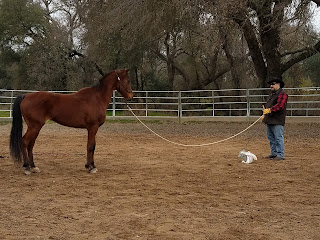ADVENTURES IN HORSEMANSHIP: Working With Jazz
A dear friend is dealing with some “life” and reached out to
us to help her with her thirteen (13) year old Paint gelding named Jazz. Jazz
is broke to saddle and has some experiences in a variety of settings and
situations but could use a refresher on being a gentleman on the ground and a
willing partner under saddle. We will have Jazz in our care for a few months
and, depending on what the future holds for his human, we hope to be able to return
Jazz in better mental, physical and emotional condition to his human or find
him a new home. This “journal” is just one of the methods we use to track
progress and evaluate challenges as they occur.
DAY 0: We picked
Jazz up in the morning. After checking out the “new-to-him” trailer he loaded
up and hauled well. We even made a stop at the local feed store. Once we got
home he unloaded with a couple of false starts. We have a rule that horses back
out of the trailer. No spinning around or other silliness. We back then out
slowly and carefully. We fell this building both trust and confidence. He
unloaded and was turned out into one of our pastures, A nice snack was waiting
for him. We checked on him several times during the remainder of the day. He
has settled in nicely. We also allow the horse to rest a bit before working
with in in our program. Tomorrow he gets loaded up and we head down the road a
bit to a local arena for a horsemanship session!
He seems to have settled in nicely!
DAY 1: WORKSHOP
PARTICIPATION – We hauled Jazz out so he and his human could attend a
horsemanship workshop locally. Since we have seen Jazz and his human work
together in the past we decided not to do a “full evaluation” on Day 0 and
figured that today at the workshop we could get one done and see where Jazz’s
starting point is as of today.
We started off Jazz’s session in the small warm up pen to
check his sensitivity to pressure on the “zones”, his overall curiosity and his
willingness to lock on. We performed an abbreviated “evaluation” in the 50’ x
80’ warm up pen at the facility. We checked his sensitivity to pressure (which
was pretty good) played with getting consistent gaits and directions/ changes
of direction (again, not bad) reactions to increases in energy/effort (a little
reactive) and get the horse to relax and look at the human (lock on/ two eyes).
All of this was done off the lead line (the safest way to meet a new horse is
being in a controlled environment without being attached to it).
Then we moved into some lead line work. We went through nine
(9) different “tests” and got a really good baseline/ starting point from which
to work. Jazz seemed to enjoy the mental stimulation and was willing to accept
leadership if giving in a calm and consistent manner.
Then it was time to get into the workshop! There were
several horses Jazz did not know in the big arena. He was curious about them
but also a little aloof. He was working with his human in the workshop. It
never ceases to amaze us how much the horse reflects what the human puts out
(even unconsciously). On the ground today we exposed jazz to some desensitizing
exercises, lateral flexion, basic lead line work with “soft” circles and gait
changes, backing up with both rhythmic and steady pressure, hind quarter yields
and the 5 in 1 exercise. The workshop covered six (6) great groundwork exercises
that really helped (and challenged) the horse, the human and their partnership.
Under saddle we work on flexion in the bridle, some Follow
the Fence (all three gaits), the Forward/Backward/Forward transition exercise,
the Charlie Brown exercise, yielding the hind end at the fence from the walk,
attempted Side Passing at the fence and we rode the Serpentine/ Cloverleaf
patterns. All in all the workshop covered seven (7) riding exercises that helped
(and challenged) the horse, the human and their partnership. Humans hit frustration
points as they broke through comfort barriers. The horses (including Jazz)
reflected that. So many of the horse’s “issues” stem from their human partners
which then become “bad habits” and then the downward spiral begins.
The day wrapped up with everyone (horse and human alike)
feeling “full” and a bit tired. Jazz did as well as we expected. On a scale
from 1 to 10 (1 being “clueless and stubborn” and 10 being “amazing”), Jazz was
a good, solid 6 to 6.5. We have some room for improvement to be sure but his
primary human is also going to factor into his growth and potential.
Tomorrow we get started with the program in the round pen
and setting up goals to help Jazz reach new levels of performance. Should be
fun!
(Sadly the battery in the camera died before we could get
pictures of the workshop.)




















